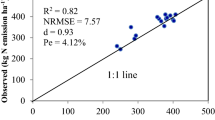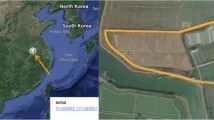Abstract
Ammonia (NH3) emission from rice (July–October) and wheat (November–April) cropping system was measured using the chemiluminescence method at the subtropical agricultural land of Delhi, India during 2009–2010 and 2010–2011. The measurement was carried out from the canopy height (1.2–1.3 m) during the different growth stages of rice and wheat crops to quantify NH3 emission and assess the variations in emission during the crop growth stages. The background atmospheric concentration of NH3 was measured at 5 m height at the study site and subtracted from the NH3 concentration at crop canopy height to quantify the emission of NH3 from crops. The NH3 emission in wheat crops were 35.9 ± 6.3, 24.5 ± 5.5, 15.8 ± 4.5, 18.6 ± 3.9, and 20.8 ± 3.8 µg m−2 d−1 during sowing, crown root initiation, panicle initiation, grain filling, and maturity stages, respectively. In rice crops, the emissions during transplanting, tillering, panicle initiation, grain filling, and maturity stages were 29.7 ± 7.4, 16.2 ± 3.7, 19.0 ± 3.7, and 18.4 ± 3.9 µg m−2 d−1, respectively. The emission was higher during sowing/transplanting compared to other stages in both the crops. About 9 % of applied fertilizer N was emitted as NH3 from the rice–wheat cropping system in the subtropical soils of India.

Similar content being viewed by others
References
Adhya TK, Pathak H, Chhabra A (2007) N-Fertilizers and gaseous –N emission from rice based cropping systems. In: Abrol YP, Raghuram N, Sachdev MS (eds) Agricultural nitrogen use and its environmental implications. IK International Publishing House Pvt Ltd, New Delhi, pp 459–475
Aneja VP, Schlesinger WH, Erisman JW, Behra SN, Sharma M, Battye W (2012) Reactive nitrogen emission from crop and livestock farming in India. Atmos Environ 47:92–103
Aulakh MS, Singh B (1997) Nitrogen losses and fertilizer N use efficiency in irrigated porous soils. Nutr Cycl Agroecosyst 7:1–16
Banerjee B, Pathak H, Aggarwal PK (2002) Effects of dicyandiamide, farmyard manure and irrigation on crop yields and ammonia volatilization from an alluvial soil under a rice (Oryza sativa L.)-wheat (Triticum aestivum L.) cropping system. Biol Fertil Soil 36:207–214
Bouwman AF, Lee DS, Asman WAH, Dentener FJ, Van Der Hoek KW, Olivier JGJ (1997) A global high-resolution emission inventory for ammonia. Global Biogeochem Cycles 11:561–587
Datta A, Sharma SK, Harit RC, Kumar V, Mandal TK, Pathak H (2012) Ammonia emission from subtropical crop land area of India. Asia Pacific J Atmos Sci 48(3):275–281
David F, Coyle M, Flechard C, Hargreaves K, Nimitz E, Robert SW, Sutton M, Erisman JW (2001) Advances in micrometeorological methods for the measurement and interpretation of gas and particle nitrogen fluxes. Plant Soil 228: 117–129
DEFRA (2010) Department of Environment Food and Rural Affair, Annual Report: Environmental impact, air quality—Indicator DC1: Ammonia Emission
FAI (2012) Fertilizer statistics 2012. Fertilizer Association of India, New Delhi
FAOSTAT (2013) Food and Agriculture Organization of United Nations, ResourceStat-Land. Accessed in July 2013
Fliesher Z, Kenig A, Ravina I, Hagin J (1987) Model of ammonia volatilization from calcareous soil. Plant Soil 103(2):205–212
Galloway JN, Aber JD, Erisman JW, Seitzinger SP, Howarth RW, Cowling EB, Cosby BJ (2003) The nitrogen cascade. Bioscience 53:341–356
Katyal JC, Singh B, Vlek PLG, Buresh RJ (1987) Efficient N use as affected by urea application and irrigation sequence. Soil Sci Soc Am J 51:366–370
Katyal JC, Singh B, Vlek PLG, Craswell ET (1985) Fate and efficiency of N fertilizers applied to wetland rice. II Punjab, India. Fert Res 6:279–290
Parmar RS, Satsangi GS, Lakhani A, Srivastava SS, Prakash S (2004) Simultaneous measurements of ammonia and nitric acid in ambient air at Agra (27°10 N and 78°05 E) (India). Atmos Environ 35:5979–5988
Patel SK, Panda D, Mohanty SK (1989) Relative ammonia loss from urea based fertilizers applied to rice under different hydrological situations. Fert Res 19:113–119
Pathak H, Li C, Wassmann R, Ladha JK (2006) Simulation of nitrogen balance in the rice–wheat systems of the Indo-Gangetic plains. Soil Sci Soc Am J 70:1612–1622
Pathak H, Mohanty S, Jain N, Bhatia A (2010) Nitrogen, phosphorus and potassium budgets in Indian agriculture. Nutr Cycl Agroecosyst 86(3):287–299
Prasad KV, Badrinath KVS (2006) Soil surface nitrogen losses from agriculture in India: a regional inventory within agroecological zones (2000–2001). J Environ Manage 73:209–218
Raynaud X, Lata JC, Leadly PW (2006) Soil microbial loop and nutrient uptake by plants: a test using a coupled C:N model of plant–microbial interactions. Plant Soil 287:95–116
Rumburg B, Mount GH, Yonge D, Lamb B, Westberg H, Neger M, Filipy J, Kincaid R, Johnson K (2008) Measurements and modeling of atmospheric flux of ammonia from an anaerobic dairy waste lagoon. Atmos Environ 42(14):3380–3393
Santra GH, Das DK, Mandal LN (1988) Field measurement of ammonia volatilization losses of nitrogen from urea applied to wheat. J Indian Soc Soil Sci 36:559–652
Schjørring JK (1995) Long-term quantification of ammonia exchange between agricultural cropland and the atmosphere—I. Evaluation of a new method based on passive flux samplers in gradient configuration. Atmos Environ 29:885–893
Sharma SK, Datta A, Saud T, Saxena M, Mandal TK, Ahammed YN, Arya BC (2010) Seasonal variability of ambient NH3, NO, NO2 and SO2 over Delhi. J Environ Sci 22:1023–1028
Sudhakara K, Prasad R (1986) Ammonia volatilization losses from prilled urea, urea super granuals and coated USG in rice fields. Plant Soil 94:293–295
Sutton MA, Bleeker A, Howard CM, Bekunda M, Grizzetti B, de Vries W, van Grinsven HJM, Abrol YP, Adhya TK, Billen G, Davidson EA, Datta A, Diaz R, Erisman JW, Liu XJ, Oenema O, Palm C, Raghuram N, Reis S, Scholz RW, Sims T, Westhoek H, Zhang FS, Ayyappan S, Bouwman AF, Bustamante M, Fowler D, Galloway JN, Gavito ME, Garnier J, Greenwood S, Hellums DT, Holland M, Hoysall C, Jaramillo VJ, Klimont Z, Ometto JP, Pathak H, Plocq Fichelet V, Powlson D, Ramakrishna K, Roy A, Sanders K, Sharma C, Singh B, Singh U, Yan XY, Zhang Y (2013) Our Nutrient World: the challenge to produce more food and energy with less pollution. Global Overview of Nutrient Management. Centre for Ecology and Hydrology, Edinburgh on behalf of the Global Partnership on Nutrient Management and the International Nitrogen Initiative. p 128
USEPA (2005) United States Environmental Protection Agency, National Emission Inventory: Greenhouse Gas Emissions and Sinks: 1990–2003, EPA 430-R-05-003, USA
Acknowledgments
Authors are thankful to the Department of Science and Technology (DST), Government of India, New Delhi for financial support (Grant No. SR/S4/AS:12/2008).
Author information
Authors and Affiliations
Corresponding author
Rights and permissions
About this article
Cite this article
Sharma, S.K., Harit, R.C., Kumar, V. et al. Ammonia Emission from Rice–Wheat Cropping System in Subtropical Soil of India. Agric Res 3, 175–180 (2014). https://doi.org/10.1007/s40003-014-0107-9
Received:
Accepted:
Published:
Issue Date:
DOI: https://doi.org/10.1007/s40003-014-0107-9




